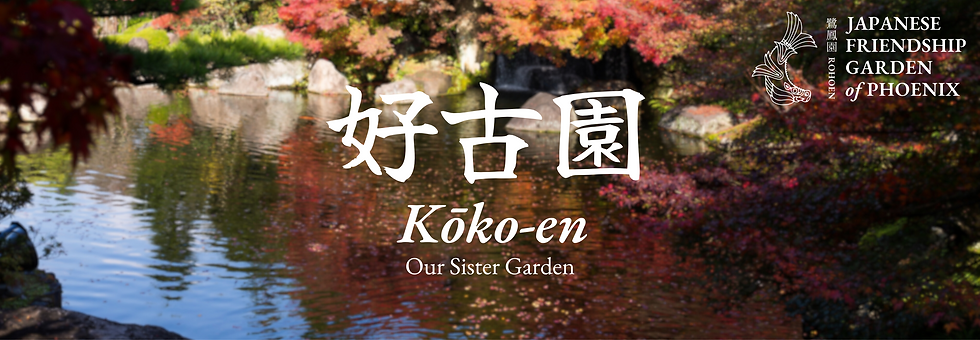Enjoying a Japanese Garden
- JapaneseFriendshipGarden

- May 17, 2023
- 4 min read
Visiting a Japanese Garden can be an enriching experience, but it's natural to wonder how to make the most of your time there. At our admission window, we often encounter questions like "how long do I spend here?" or "what do I do in the Garden?" These inquiries are valid and lead us to another important question: how do you enjoy a Japanese Garden? To gain insight into this, let's explore the historical significance of Japanese Gardens and how they have been appreciated throughout the ages.
In early Japan, before 794 AD, Gardens held sacred significance and were often nestled in natural surroundings, marked by pebbles. These serene spaces were designed for quiet contemplation, meditation, prayer, and creating a deeper connection with nature. During the Heian period in Japan (795-1185), private gardens gained popularity among aristocrats, drawing inspiration from the gardens at the imperial palace. These gardens served as venues for recreational activities such as boating, fishing, and lively parties. Every element of garden design was carefully considered, even accommodating the placement of musicians during grand events.

Moving ahead to the late 19th and 20th centuries, Gardens in Japan transitioned from private residential environments to public attractions with regular operating hours. This shift mirrors the practice in the West, where gardens are often transported for exhibitions at world fairs (how the Tea Garden in San Francisco originated). Following World War II, a desire to reestablish bonds with Japan sparked a fresh wave of interest in Japanese culture from the West. This renewed enthusiasm led to the transformation of Japanese Gardens into symbols of beauty, serenity, international cooperation, and cultural education. The United States, for example, boasts numerous 'Friendship Gardens' as testaments to this renewed connection.
---
So how can this history teach us to enjoy a modern Japanese Garden?
Dr. Kendall Brown, a leading researcher in Japanese Gardens spoke about finding the purpose of Japanese Gardens at the Japanese Friendship Garden of Phoenix in November of 2022. He states:
'Modern visitors experience the Garden and its objects as a museum, with passive visual contemplation. While this is one way to enjoy the Garden, it is not the only way, nor should it be considered the 'proper method.'
Numerous gardens throughout the West, including our own, curate an atmosphere of sophistication and beauty while implementing rules to protect the garden's integrity. However, as Dr. Brown suggests, this does not mean that garden enjoyment should be passive. Taking inspiration from the Heian period aristocrats, we can still celebrate and have fun in modern Japanese Gardens. Cultural events, as well as wedding and celebration rentals, offer opportunities for families and friends to rejoice in the splendor of these settings.
Alternatively, we can go even further back in time and find inspiration in how the early Japanese utilized natural spaces for contemplation and meditation. Today, our Japanese Garden also serves as a place for visitors from around the world to seek solace, find moments of healing, and engage in introspection within a picturesque environment.

With Japanese Gardens in the West, they also serve a purpose of education about Japanese culture. Dr. Brown describes Western Japanese Gardens as "dreams of elsewhere and constructions of otherness. As microcosms of an idealized Japanese tradition [...] a way of connecting idealizations of nature that restore us physically and mentally. They are a cultural interpretation of nature redefined into a compelling and inspiring design forms transportable across time and space, " (2017). By visiting a Japanese Garden, we can immerse ourselves in another country's culture, allowing us to learn and grow along the way.
Modern Japanese Gardens can also be considered 'living art' that is constantly nurtured, and ever changing. There is always something new to appreciate and see at a Japanese Garden, from seasonality, to new plants, to reshaped trees and shrubs, the landscape is ever evolving to push the boundaries of Garden art. This evolution can lead to wonder and inspiration for our guests, with many artists visiting to sketch or take photos of the beautiful environment.
Overall, these environments serve as a place for physical and mental healing, for repose, for individual and social transformation, for education, for celebration, for inspiration, for connection to nature, and to those that we love.

These are only a few of the ways that the Garden can serve our guests, and ultimately what the Garden can give you is up to the individual. We at the Japanese Friendship Garden of Phoenix only ask that you come in with a curious and open mind, and a willingness to be in the present. From there, enjoyment will arrive time and time again.
Next time you visit, consider these activities:
Enjoying a book
Sketching the environment
Enjoying time with friends and family
Meditating or taking a moment to enjoy the beauty of the nature around you
Walking the Garden for health and wellness
Using the space to heal or recover from grief
Learning more about Japanese culture through a tour
Bird watching
Renting the Garden for a wedding
Attending a cultural event at the Garden
Joining a Gardening Workshop
Cited: "Visionary Landscapes: Japanese Garden Design in North America, The Work of Five Contemporary Masters" by Kendall H. Brown. Tuttle, 2017.
.png)



Moss carpets the shaded corners, and koi fish lazily glide beneath the arched wooden bridge.